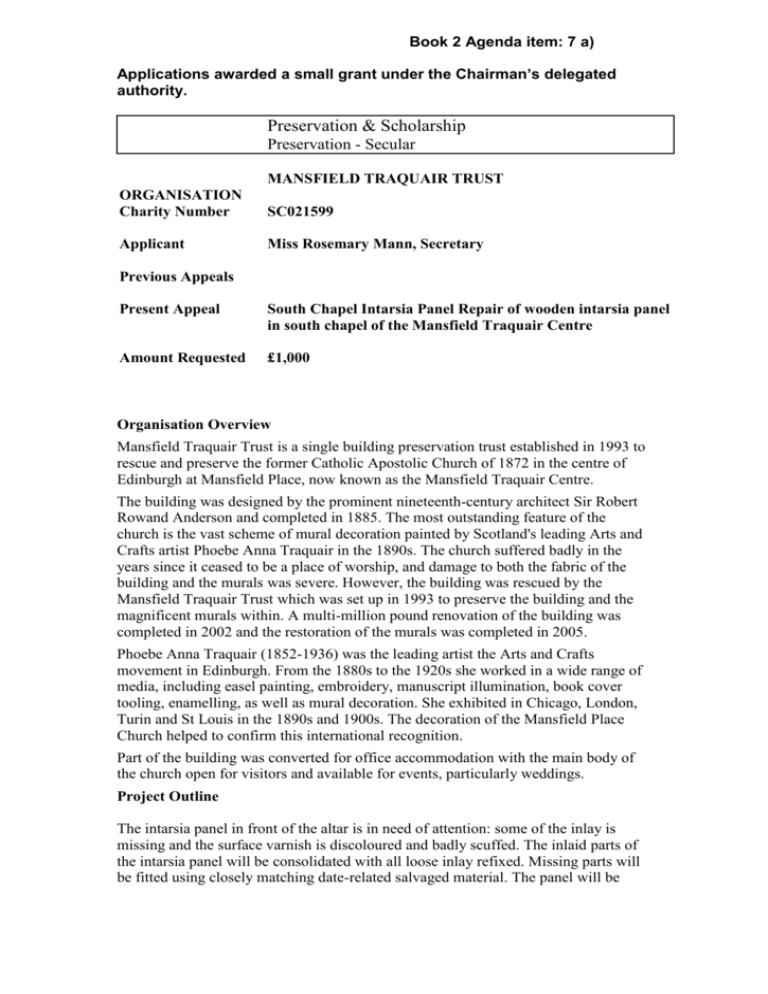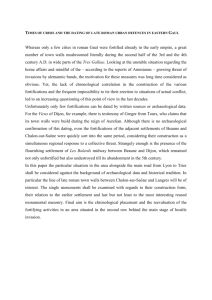Book 2 Agenda item: 7 a) Applications awarded a small grant under
advertisement

Book 2 Agenda item: 7 a) Applications awarded a small grant under the Chairman’s delegated authority. Preservation & Scholarship Preservation - Secular MANSFIELD TRAQUAIR TRUST ORGANISATION Charity Number SC021599 Applicant Miss Rosemary Mann, Secretary Previous Appeals Present Appeal South Chapel Intarsia Panel Repair of wooden intarsia panel in south chapel of the Mansfield Traquair Centre Amount Requested £1,000 Organisation Overview Mansfield Traquair Trust is a single building preservation trust established in 1993 to rescue and preserve the former Catholic Apostolic Church of 1872 in the centre of Edinburgh at Mansfield Place, now known as the Mansfield Traquair Centre. The building was designed by the prominent nineteenth-century architect Sir Robert Rowand Anderson and completed in 1885. The most outstanding feature of the church is the vast scheme of mural decoration painted by Scotland's leading Arts and Crafts artist Phoebe Anna Traquair in the 1890s. The church suffered badly in the years since it ceased to be a place of worship, and damage to both the fabric of the building and the murals was severe. However, the building was rescued by the Mansfield Traquair Trust which was set up in 1993 to preserve the building and the magnificent murals within. A multi-million pound renovation of the building was completed in 2002 and the restoration of the murals was completed in 2005. Phoebe Anna Traquair (1852-1936) was the leading artist the Arts and Crafts movement in Edinburgh. From the 1880s to the 1920s she worked in a wide range of media, including easel painting, embroidery, manuscript illumination, book cover tooling, enamelling, as well as mural decoration. She exhibited in Chicago, London, Turin and St Louis in the 1890s and 1900s. The decoration of the Mansfield Place Church helped to confirm this international recognition. Part of the building was converted for office accommodation with the main body of the church open for visitors and available for events, particularly weddings. Project Outline The intarsia panel in front of the altar is in need of attention: some of the inlay is missing and the surface varnish is discoloured and badly scuffed. The inlaid parts of the intarsia panel will be consolidated with all loose inlay refixed. Missing parts will be fitted using closely matching date-related salvaged material. The panel will be Book 2 Agenda item: 7 a) Applications awarded a small grant under the Chairman’s delegated authority. sanded to remove the existing varnish and damaged surface and revarnished with four costs of matt varnish. Churches of the ecclesiological movement are often highly decorated, the richness of the decoration increasing towards the liturgical east end. Whereas the flooring in the nave is often wooden boards or plain tiles, the chancel and apse floors are usually stone or patterned tiles. The Catholic Apostolic Church is unusual as it not only has increasingly elaborate floor tiles as one approaches the altar, but it has intarsia panels in front of the altars. Apparently, no other church in Scotland has such panels. When new, the different coloured woods would have glowed with vibrant colour giving the effect of a rich carpet. It is hoped to see this effect when the panel in the south chapel is restored. Financial Information Cost of conservation work....................................£3,000 Applications made to: Gordon Fraser Charitable Trust £500 Hazel M Wood Charitable Trust £500 Russell Trust £1,000 Requested from the Pilgrim Trust,,,,,,,,£1,000 Comments It is difficult to get excited about this panel, but it is in a sorry state and will, no doubt, look rather more impressive once the conservation work has been carried out. There is no doubt, however, about the spectacular decoration in the Church. It is quite breathtaking. A grant of £1,000 is recommended. Book 2 Agenda item: 7 a) Applications awarded a small grant under the Chairman’s delegated authority. Book 2 Agenda item: 7 a) Applications awarded a small grant under the Chairman’s delegated authority. Preservation & Scholarship Preservation & Scholarship - Research SAVE BRITAIN'S HERITAGE ORGANISATION Charity Number 269129 Applicant Mr William Palin, Secretary Present Appeal Fortifications at Risk; New Initiatives to save military structures Amount Requested £3,500 Organisation Overview SAVE was formed in 1975, European Architectural Heritage Year, to draw attention to the needless and continuing destruction of historic buildings and to campaign for their rescue through press releases, reports and exhibitions. SAVE publications continuously highlight historic buildings and places which are at risk from decay, neglect, destruction and redevelopment. Although SAVE’s finances looked a little shaky in 2009/10, it has explained that during the last financial year it spent a little more freely as it was expecting two legacies in the first quarter of this year - totalling over 400k. It has also shed one full time member of staff which is helping to balance the books ahead of these promised funds. Project Outline The Pilgrim Trust is asked for funding to allow the research leading to a publication on Fortifications at Risk; New Initiatives to save military structures. The central theme is that, in the past, people have looked to Governments and public bodies to save fortifications, castles and forts as ancient monuments, open to the public. Today, a much wider range of fortifications is considered of interest, many dating from the 19th and 20th centuries. These include forts, batteries, ramparts, gun emplacements, tunnel works and below ground installations, on both sides of the Channel, for example as the Maginot Line and the Atlantic Wall ranging across a whole series of European Wars, notably the 1st and 2nd World Wars, and the Cold War. A race is on to identify and explore these structures but they are so numerous and often large that their care and preservation must, and is, being undertaken by a growing range of volunteers and voluntary bodies, preservation trusts and local groups dedicated to individual fortifications. While some can be looked after and opened by volunteers others are earning their keep by ingenious conversion as holiday lets, pioneered by bodies such as the Landmark Trust. The report will describe the large number of Book 2 Agenda item: 7 a) Applications awarded a small grant under the Chairman’s delegated authority. recent initiatives in Britain and abroad, aimed at identifying, recording, protecting and opening fortification sites, as well as finding new uses. Other notable initiatives to rescue and open neglected historic British fortifications have taken place in Menorca. In America the Battlefields Preservation Society has an active programme of taking (and buying) easements (covenants) on sites to protect them from development. This project will initially be presented by SAVE’s president Marcus Binney as a 40 minute keynote address to the Fortress Study Group Symposium 'Fortifications at Risk'. It will be published as an illustrated SAVE report. Financial details Research, travel and photography and assembly of illustrations, writing and editing £2,500. Design and printing £2,000 Launch and marketing £500 Requested from the Pilgrim Trust.......................£3,000 Comments SAVE is a well respected campaigning organisation that has scored a number of heritage "victories", not least Dumfries House. A grant of £3,000 would enable another one of its flag waving, but scholarly publications to be produced. Book 2 Agenda item: 7 a) Applications awarded a small grant under the Chairman’s delegated authority.









